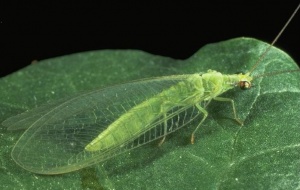Mallada sp.

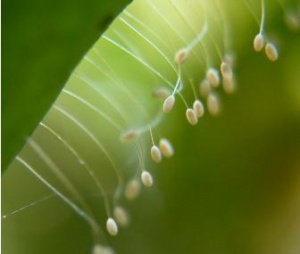
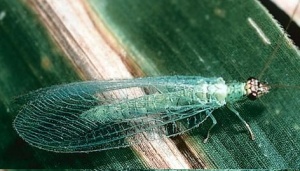
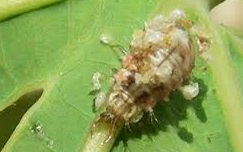
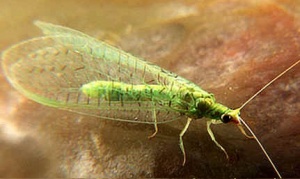
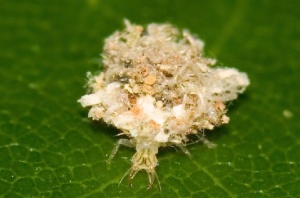
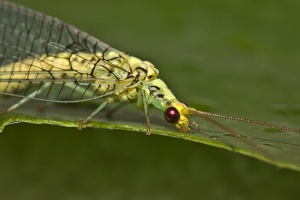
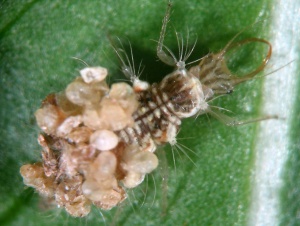

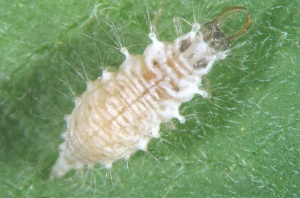
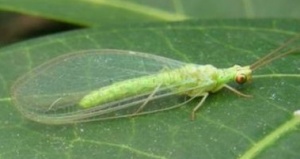

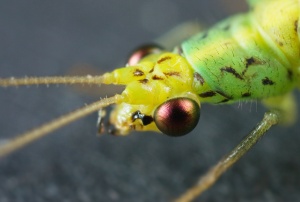
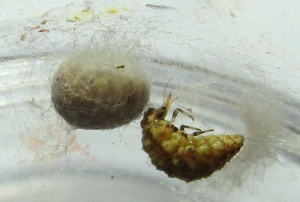

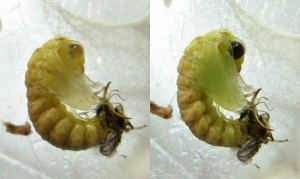

Mallada species are green lacewings with 4 clear wings. Most lacewings (also) feed on plant material, such as pollen. Particularly green lacewings (Chrysopidae) such as Mallada boninensis, Mallada astur and Mallada signata are mainly predatory and very effective. They are relatively small (length up to 1.5 cm, including wings). Adults are active during the night, and may be attracted by flashlight. Most pesticides and high-copper fungicides are toxic to lacewings. A female lacewing may plant over 100 eggs on plants infested with aphids. These eggs hang on a thin 1 cm long stalk, most often under a leaf. The eggs hatch within 4 days. The larval period lasts 12 days, and the pupal period lasts about 9 days. The larvae have spines on their back that they impale the remains of their prey on, for camouflage. Adults live just one month. One may commercially rear millions of green lacewings for biological control of mango pests.
One may buy millions of lacewings (as captive-bred eggs) for biological pest control (eg in mango cultivation), as reared for that purpose in many countries. One may rear green lacewings on Armyworm eggs. The larvae of most species of lacewings are specialised predators that eat aphids (and coccids such as mango scales, and caterpillars). These larvae sway their heads from left to right, and back, until they strike something they can eat. They have mouthparts that can pierce and suck the aphids. Many (adult) lacewing species also feed on nectar and pollen, but particularly Chrysopidae (eg Mallada signata, Mallada boninensis) are mainly predatory (one adult may eat 15 aphids per day). One may attract Chrysopidae by planting crops that attract them (mainly Asteraceae and Apiaceae), such as calliopsis (Coreopsis), cosmos (Cosmos), sunflowers (Helianthus), dandelion (Taraxacum), dill (Anethum) and angelica (Angelica).
Adult chrysopids have paired prothoracic glands that are thought to produce defensive secretions.[1]
Contents
Mallada alcestes
Mallada alcestes are native to India [2] and may be successfully mass-reared on a diet of on eggs of Tribolium castaneum (larval diet) and on a 2 : 3 mixture (by weight) of Amber BYF Series 100^[○!R] and honey at 26°±0.5℃ under a 16L : 8D photoperiod.[3]
Mallada astur
Mallada astur is common in India.[4] One Mallada astur individual may eat 50 aphids per day.[5] Mallada astur has a 24.5 days total life cycle on a combined diet of eggs and larvae of Opisina arenosella (the coconut black-headed caterpillar), with a mean of 102 egg laid per female.[6] On a diet of frozen grubs of Tribolium castaneum (red flour beetle), the total life cycle was 21 to 23 days, the incubation period lasted 3 days, the larval period 9 days and the pupal period 9 to 10 days. Larval survival was 77%.[7] M. astur larvae take longer to develop (16 days) on whitefly nymphs (Aleurodicus dispersus) than on rice moth eggs (Corcyra cephalonica); only 13 days. During its larval development, it may eat 235 whitefly nymphs in total.[8]
Mallada basalis
Mallada basalis is an indigenous species in Taiwan and the Pacific Islands. It may be succesfully reared on eggs of the rice moth, Corcyra cephalonica.[9] Optimum feeding temperature may be 30℃. [10]. Dietary protein is the major factor for fecundity, longevity, and body weight, which increase in association with protein contents in the diet.[11] Flight of Mallada basalis has two twilight peaks, one at dusk and one at dawn.[12] On average, the female M. basalis produces 466 eggs. Incubation period is 2.3 days. The mean duration of the 3 instars is 2.4 days, 2.2 days and 4.4 days respectively. During those days, these 3 instars may respectively eat 18, 45 and 223 aphids. (In total 285 on average during the entire larval stage) The highest rate of pupation was achieved when each larva was fed 2 to 4 grams of (Corcyra cephalonica) eggs during the larval stage. Pupal stage lasts about 9 days. Longevity of adult males is 27 days, and of adult females is 43 days when fed aphids, and at 25°C and 75% relative humidity.[13]
Another study showed that a complete life cycle took 28 days. Mallada basalis may have 10 generations per year, depending on temperature, as time required to complete a lifcycle decreases with increasing temperatures. Lifecycle is shortest at 30℃. Females averagely laid 736 eggs. Its eggs may take 4 days to hatch. Larval stage takes 12 days and pupal stage also 12 days. Female life span was 71 days and male life span 77 days. The overall high and low lethal temperatures were 17 to 42℃.[14] On a microcapsulated artificial diet females laid 348 eggs on average.[15] Mallada basalis substantially suppresses populations of the fruit mites Tetranychus kanzawai and Panonychus citri.[16].
Mallada basalis grows faster on rice moth eggs than on artificial diet. By using corrugated strip paper as shelter larval cannabalism is prevented and 80% of larvae develop into adults. One may rear 300 green lacewing larvae in 0.02 m3 plastic boxes, with 91% of larvae developing into adults. Releasing 3 second instar larvae on each sweet pepper plant every 10 days gives effective control of whiteflies and aphids.[17] Using corrugated strip paper rolls and scratched polystyrofoam powder as shelter decreases larval cannibalism and produces 28% and 14% more adults than control, respectively. An evenly distributed food supply increases the rate of adult emergence 9%. The method including all these factors increased by 90% in total the lacewing larvae as adults. In a plastic box of size 14x 11.2x 7 cm, three rolls of corrugated strip paper of width 1.5 cm and length 185 cm were piled in three layers, and scratched polystyrofoam powder 2.5 ml mixed with frozen-sterilized Corcyra cephalonica eggs 0.4g were evenly distributed in the box. Then, 100 neonates of green lacewing were inoculated. The container was covered with polyethylene fine wrap and placed in a growth chamber at temperature 28℃, 75RH and photoperiod 14L:10D. Additional Corcyra eggs 1.4g were supplied on days 4 and 7 after inoculation. An average rate 80% of adult harvest was obtained.[18]
pesticides The following pestcides caused less than 50% mortality in Mallada basalis larvae: hexythiazox, fenbutatin oxide, chinomethionat, fenpyroximate, fenothiocarb, abamectin and 9 fungicides: carbendazim, vinclozolin, mancozeb + metalaxyl, metiram + vinclozolin, iprodione, procymidone, carbendazim + metiram, prochlorate manganese and benomyl. Of the insectisides tested, Carbofuran caused 100% mortality. The following insectisides caused 80 to 99% mortality: methomyl, chlorpyrifos, mevinphos and permethrin. Deltamethrin caused 50-79% mortality. Fenvalerate and cypermethrin caused less than 50% mortality.[19]
Mallada boninensis
This green lacewing (aka Aphid Lion) is indigenous to various Asian countries, including India, China and Taiwan. Mallada boninensis (aka Mallada desjardinsi) is an effective [20] generalist predator, feeding on mealy bugs (Mani and Krishnamoorthi, 1987), white flies (Selvakumaran et aI., 1996), bollworms and aphids (Kabissa et al., 1996) and on nymphs of Aphis gossypii, Aphis craccivora and Rhopalosiphum maidi [21], blackflies, psylla and leaf miner. Biological control would be best achieved by mass rearing and seasonal colonization of M. boninensis.[22] Green lacewings are recommended for the integrated pest management programme (Nehare et al., 2004), and may be released at 30 larvae per tree.[23]
In laboratory settings, longevity of Mallada boninensis males was 62 days and 102 days for females. The mean number of eggs laid by females was 400. The optimum temperature for predation was 35°C. Individuals averagely consumed 149 larvae of the Citrus leaf miner (Phyllocnistis citrella).[24]
M. boninensis feeds well on Corcyra cephalonica eggs[25] (Rice Moth; laboratory host), with better outcomes on sterilized eggs in comparison to unsterilized eggs and neonates.[26] C. cephalonica can be mass reared on Jowar along with groundnut, streptomycin, vitamin complex, Na and K salts. Alternatively, M. boninensis may also be reared on eggs of Aleurocanthus woglumi and Aleurocanthus gossypii (both Whitefly species) [27], or on neonates of Spodoptera litura, Helicoverpa armigera (African bollworm) and Earias vitella (Spotted bollworm). Among the latter 3, M. boninensis Longevity and reproductive potential was best on neonates of the Spodoptera litura (Oriental Leafworm Moth aka Tropical armyworm).[28] Nymphs of Aphis gossypii, Aphis craccivora and Rhopalosiphum maidis also have good effect on its development and its multiplication.[29] Mallada boninensis may also be reared on eggs of Tribolium castaneum; the Red flour beetle (larval diet) and on a 2 : 3 mixture (by weight) of commcrcially-available yeast autolysate (AY-65 or Amber BYF Series 100^[○!R]) and honey (adult diet).[30]
Mallada desjardinsi
Mallada desjardinsi is also known as Mallada boninensis, though the literature may not be consistent. The temperature range for optimal development of Mallada desjardinsi is 17.5° to 25°C.[31] M. desjardinsi development from eggs to adults takes 32 days on average. The development of eggs, larvae and pupae takes 5 days, 14 days and 13 days respectively. After a mean pre oviposition period of 7 days, one female averagely lays 253 eggs during her life time. Male adult longevity is 40 days. Female adult longevity is 58 days. Silkworms may be utilized as alternate host material for maintenance of culture as well as production of M. desjardinsi.[32] M. desjardinsi may produce 10 to 11 overlapping generations per year.[33]
Green lacewings predate on various small bugs, including aphids. Various ant species farm and protect aphids against their natural enemies, including green lacewings. Larvae of Mallada desjardinsi, prey on cowpea aphids, but are not attacked by farming ants because these M. desjardinsi larvae carry aphid carcasses on their backs. The cuticular hydrocarbons in these carcasses function as a chemical camouflage to limit attacks by aphid-tending ants.[34] Lacewings such as Mallada desjardinsi respond to the green leaf volatiles (plant odors) emanating from plants attacked by mealybugs.
M. desjardinsi also predates on the Red spider mite, a tea pest. The optimum predator-prey ratios are 1:50 and 1:33 under laboratory conditions and the ratios were 1:33 and 1:25 in green house conditions.[35]
Mallada signata
Mallada signata is native to Australia and New Zealand. Adults are 16 mm long and live about 3 to 4 weeks. Most pesticides are toxic to lacewings, and even fungicides may be disruptive. Mallada signata predates on a wide range of common pests, such as aphids, whitefly, mites, scales, small caterpillars and moth eggs. Lacewings (both larvae and adults) are most effective against aphids and at 25°C and 60% to 65% relative humidity. Females will start laying eggs 1 week after emergence, and may lay up to 600 eggs. Eggs are laid on fine stalks. Newly hatched larvae immediately start eating aphids and may grow up to 8 mm in 12 days. Larvae have pinchers for attacking prey. They carry debris on their backs. The larvae may eat hundreds of aphids in those 12 days until pupation. Adults emerge after 9 days.
Rearing lacewings, one needs to provide them with food continuously (eg http://www.waiwiki.org/index.php?title=Armyworm Armyworm] eggs), to prevent canabalism. Mass-reared Mallada signata are commercially available. They are supplied as eggs from which larvae will hatch within days. Distribution in the field: Initially 5 eggs per square meter, followed by releases of 1 egg per square meter.
The silk produced by Mallada signata is tougher silk than the silk produced by silkworms; it may be stretched up to six times further than silkworm silk. This silk is used to create tiny stiff stalks to hold each of its eggs on.[36] M. signata produces two (more) distinct classes of silk. The final instar larvae spin protein fibers to construct a loosely woven cocoon. In a second stage of cocoon construction, the insects lay down an inner wall of lipids that uses the fibers as a scaffold. These larval cocoon silk and egg-stalk silk are not related. The silk protein fibers may provide the mechanical strength of the composite lacewing cocoon whereas the lipid layer may provide a barrier to water loss during pupation.[37] . The innermost layer of the cocoon, the pelade, helps prevent abrasion of the waterproof external cuticle of the pupa during its frequent movements within the cocoon. Cocoon fibers also have both antifungal and antibacterial properties [38]
Specific hybrids of wild and cultivated tomato plants (meant to reduce pesticide use) negatively effects Mallada signata (increasing mortality).[39]
